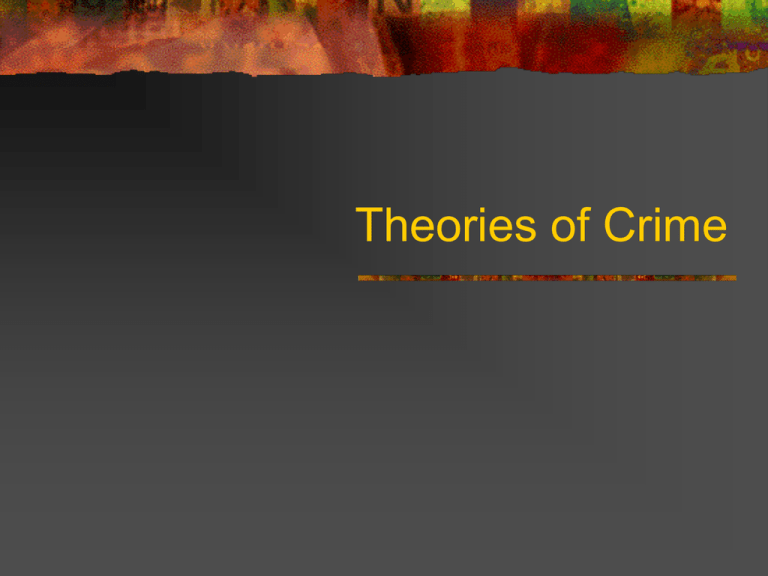Theories of Crime
advertisement

Theories of Crime
Lombroso
Lombroso in 1876 argued that the criminal
is a separate species, a species that is
between modern and primitive humans.
He argued that the physical shape of the
head and face determined the "born
criminal".
Lombroso
1.
2.
3.
William Sheldon believed that people could
be classified into three body shapes, which
correspond with three different personality
types.
endomorphic (fat and soft) tend to be
sociable and relaxed.
ectomorphic (thin and fragile) are introverted
and restrained
mesomorphic (muscular and hard) tend to
be aggressive and adventurous.
Sheldon, using a correlational study, found
that many convicts were mesomorphic, and
they were least likely to be ectomorphic
(Sheldon et al 1949).
Sheldon
Genetic - XYY
Normal Male
Genetic - XYY
XYY Male
Genetic - XYY
Jacobs et al (1965) suggested that men with
the XYY syndrome were more aggressive
than normal 'XY' men. XYY men are overrepresented in the prison population. There
are 15 sufferers per 1,000 in prisons and 1 per
1000 in the general population.
XYY Male
Neurophysiological
Raine 1994 used PET scans to study the living
brains of impulsive killers. Damage was found in
the pre-frontal cortex, which controls impulsive
behaviour. The task used involved sustained
attention. It involved watching a screen for 32
minutes and responding every time a 0
appeared. Impulsive individuals also missed
many of the 0s. Oddly enough, pre-frontal under
arousal has also been found in politicians!
Neurophysiological
PET Scanner
Neurophysiological
PET Scan
ADHD
ADHD
Another suggestion is that certain
individuals, as a result of genetic
predisposition or brain damage at birth,
suffer from a cluster of symptoms which
render them incapable of moral control
and because of cortical under arousal,
they are constantly seeking stimulation.
Neurochemical
The brain’s chemistry can be influenced
by diet, for example, food additives,
pollution or hypoglycaemia (low blood
sugar levels associated with forms of
diabetes). Dawn Stanton attacked her
husband with a knife when
hypoglycaemic. But not all diabetics
without insulin act criminally.
Neurochemical
Individuals who take large amounts of
steroids can become extremely violent
(known as "roid rage"). Steroids, usually
taken to increase muscle growth, also
increase testosterone levels. Horace
Williams, a body builder, beat a man to
death after taking two thousand times the
recommended dosage of steroids.
Family Studies
Twin studies
An 'MZ apart' study is when two monozygotic
children have been brought up apart. If both turn
out to be criminals then this would be support for
the genetic explanation. The degree of similarity
between two twins is known as the
concordance rate. This rate can then be
compared with dizygotic twins who are brought
up together ('DZ together').
Looking at a number of studies the average
concordance rate is 55% for MZ twins and 17%
for DZ twins (Bartol, 1999).
Monozygotic twins
Evaluation
•
Different studies define criminality in different ways
(e.g. traffic violations, military offences, treason during
World war 2).
•
Quasi-experimental designs are not so controlled as
experimental designs.
•
Age of separation of MZ twins.
•
Misclassification of twins as MZ or DZ.
Evaluation
•
MZ twins look alike and may therefore generate more
similar social responses than DZ twins. This means that
in addition to sharing the same genes, they may also
share an almost identical social environment.
•
MZ twins often have a very close: relationship and may
therefore develop similar interests, which might include
criminal behaviour.
Evaluation
•
Very small sample size in some studies, because of the
inherent difficulties in obtaining access to criminal twins.
•
Variable definitions of criminal behaviour.
adoption studies
A retrospective study by Mednick et al (1987)
looked at court convictions in a small European
country and found 14,000 adoptees amongst
them. The criminal records of their biological and
adoptive parents were then investigated. Many
of the adoptees had criminal biological parents
(particularly strong relationship for sons and
fathers). There was no relationship in the types
of crime committed. Where there was an
improvement in social conditions there was a
reduction in crime (going against the genetic
explanation).
adoption studies
Biological parents
have criminal record
Adoptive parents
have criminal record
No
Yes
No
Yes
% of sons with
criminal record
(Mednick 1987)
% of sons with
criminal record
(Bohman, 1995)
No
13.5
3
No
20.0
12
Yes
14.7
7
Yes
24.5
40
Evaluation
1 Age of adoption
2 Amount of contact with biological parents
(contamination effect)
3 Adoptive family selected to be similar to
biological family.
4 Small sample sizes.
Psychological:
Eysenck's Personality theory
Extraverts need excitement so they are more likely to
seek crime in order to gain excitement.
Eysenck proposed that extraverts do not condition
easily. Whereas others would learn that crime does not
pay through classical and operant conditioning, the
extravert would not learn these associations.
Eysenck’s Personality Theory
FREUDIAN APPROACH
Traumatic Experiences
Traumatic experiences in
early childhood leave their
mark on the individual
despite the fact that the
individual was not aware
of these experiences.
http://www.uwm.edu/Cour
se/820101/Kaleta/InS00Personali
tyFreud.htm
Freud and Effect of Family
Alexander and Healy (1935) suggested that
children need to progress from the pleasure
principal (being id dominated and therefore
needing instant gratification) to the reality
principle (where the ego is dominant). Criminals
are those children who do not make this
transition. According to Freud the child needs a
stable home environment in order to
successfully make this transition. Research has
supported the fact that most criminals come
from unstable homes.
FREUDIAN APPROACH
John Bowlby (1946) (see Hodges and Tizard)
studied 44 juvenile delinquents and compared them
with non-criminal disturbed juveniles. 39% of the
delinquents had experienced complete separation
from their mothers for six-months or more during
the first five years of their lives compared with 5%
of the control group.
Problems with Bowlby's research:
unrepresentative samples
poor matching for control group
low reliability in the interviews with
participants
(Feldmann 1977).
Evidence against Bowlby
Koluchova (1976) studied a pair of Czech twins
and reported that although they were severely
neglected for the first 7 years of their lives they
were deemed normal by the time they were 14
after being cared for.
Clarke and Clarke (1976) studied children from
deprived backgrounds using a longitudinal study
and found there were many factors that
contributed to the child becoming a criminal, not
just whether or not they were maternally
deprived.
However (Fred and Rosemary)
However, the effects
of emotional or
sexual abuse can
well be believed
when we find that
'serial killers' such
as Frederick and
Rosemary West
suffered terribly as
children (Wansell
1996).
Child abuse
Out of 36 sex murderers interviewed in the USA
42% were found to have been sexually abused
as youngsters (Ressler et al 1988).
Dietz and Warren (1995) found that 76% of the
41 serial rapists that they interviewed were
abused when young.
But only about 10% of abused children go on to
commit crimes.
Bandura's Social learning
theory
Bandura (1977) suggests that there are three
aspects to motivation:
1. External reinforcement (as in operant theory)
2. Vicarious reinforcement – the observation of
other people being rewarded or punished for
their behaviour
3. Self-reinforcement – gaining internal
satisfaction from an activity, which therefore
motivates the individual to behave in a similar
way in the future.
Bandura 1976
Observational learning is thought to take
place primarily in three contexts:
1. In the family
2. in the prevalent sub culture
3. Through cultural symbols such as
television and books.
Learning theory and social learning
theories of crime evaluation
For
The theories are based on carefully conducted
empirical research
They can help to explain why criminality does, to
an extent run in families.
Males and females are socialised very
differently, with females encouraged not to be
aggressive and to conform, males are
encouraged to “stick up for themselves” and be
independent.
Learning theory and social learning
theories of crime evaluation
Against
The studies on which these theories are
based are conducted in laboratories or
other artificial environments in carefully
controlled conditions. They therefore lack
ecological validity in that they may not be
sampling behaviour as it occurs in real life
situations.
Learning theory and social learning
theories of crime evaluation
Against
The fact that criminal behaviour tends to run in
families is not necessarily due to imitation but
may be due to circumstances such as social
deprivation, or to genetic propensity to behave
in an anti-social way.
There are biological differences between men
and women, especially hormonal ones, and this,
rather than socialisation, may account for
differential rates of crime between men and
women.
Sutherland (1939)
‘differential association’
criminal behaviour is learned;
the learning is through association with other
people;
the main part of the learning takes place within
close personal groups;
the learning includes techniques to carry out
certain crimes and also specific attitudes and
motives conducive towards committing crime;
Sutherland (1939)
‘differential association’
the learning experiences — differential
associations — will vary in frequency and
importance for each individual;
the process of learning criminal behaviour
is no different from the learning of any
other behaviour.





